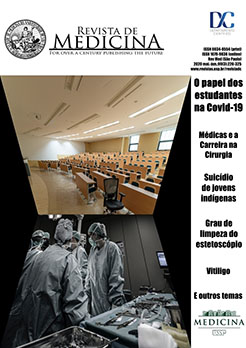Evaluation of the presence of microorganisms isolated from the surface of the stethoscope diaphragm used by UNIPAM medicine course students
DOI:
https://doi.org/10.11606/issn.1679-9836.v99i3p242-245Keywords:
stethoscope, biological contamination, microorganisms, bacterium, medical studentesAbstract
Abstract: healthcare-associated infections (iacs) represent a problem that requires care in brazil, being among the first six causes of death in the country, so that this cause is strongly linked to the imbalance of microbiota and host immunity. Among the instruments that may contribute to the onset of iacs, the stethoscope stands out, which can be an important vector of cross infection if not properly cleaned. The objective of this study was to identify the prevalence and the main agents present in the diaphragms of stethoscopes of medical students at unipam and also to propose the importance of their correct hygiene. An observational, cross-sectional and descriptive study was conducted by collecting microbiological material from 52 stethoscopes. Samples were collected with sterile swab moistened in physiological solution and inoculated in bhi broth (brain heart infusion) and inoculated in petri dishes containing standard counting agar (pca) and methylene blue eosin agar (emb). For the characterization of the cultures, bacterial identification techniques were used by inoculation and traditional biochemical series, after which gram staining was performed and the morphotintorial characteristics were analyzed. Of the 52 diaphragms of stethoscopes evaluated, only 50% (n = 26) showed positive growth contamination in the pca medium. The isolated bacteria had the following morphology and tintorial characteristics: gram negative and gram positive cocci; gram positive and gram negative bacilli. 65% (n = 17) were gram negative, an important organism present in infections. The results show that gram-negative bacteria prevailed over gram-positive bacteria, which are important pathogens. There was contamination of stethoscopes by bacterial genera associated with diseases. In this sense, it can be concluded that the practice of cleaning the diaphragm of stethoscopes should be better disseminated in educational institutions.
Downloads
References
- Moraes CL, et. al. Contaminação de equipamentos e superfícies de unidades de terapia intensiva de uma maternidade pública por Staphylococcus coagulase negativa. Rev Patol Trop. 2013;42(4):387-94. doi: 10.5216/rpt.v42i4.27927.
- Sales VM, et al. Análise microbiológica de superfícies inanimadas de uma Unidade de Terapia Intensiva e a segurança do paciente. Rev Enf Ref. 2014;3:45-53. http://dx.doi.org/10.12707/RIII1293.
- Murray P, Rosenthal KS, Pfaller MA. Microbiologia médica. Elsevier Brasil; 2015.
- Dutra LGB, et al. Prevalência de contaminação bacteriana em estetoscópios. Rev Inst Adolfo Lutz. 2013;72(2):155-60. doi: 10.18241/0073-98552013721557.
- Neves JDB, et. al. Análise bacteriológica de jalecos de profissionais da saúde de uma clínica escola na cidade de Juazeiro do Norte, Ceará. Rev Interfaces. 2015;3(9):50-4. doi: 10.16891/2317-434X.535.
- Sales WB, et al. Quantitativo microbiano em jalecos de estudantes da área da saúde em instituição de ensino superior. J Health Sci Inst. 2016;34(4):195-9. Disponível em: https://www.unip.br/presencial/comunicacao/publicacoes/ics/edicoes/2016/04_out-dez/V34_n4_2016_p195a199.pdf.
- Xavier MS, Ueno M. Contaminação bacteriana de estetoscópios das unidades de pediatria em um hospital universitário. Rev Soc Bras Med Trop. 2009;34(2):217. http://dx.doi.org/10.1590/S0037-86822009000200026.




